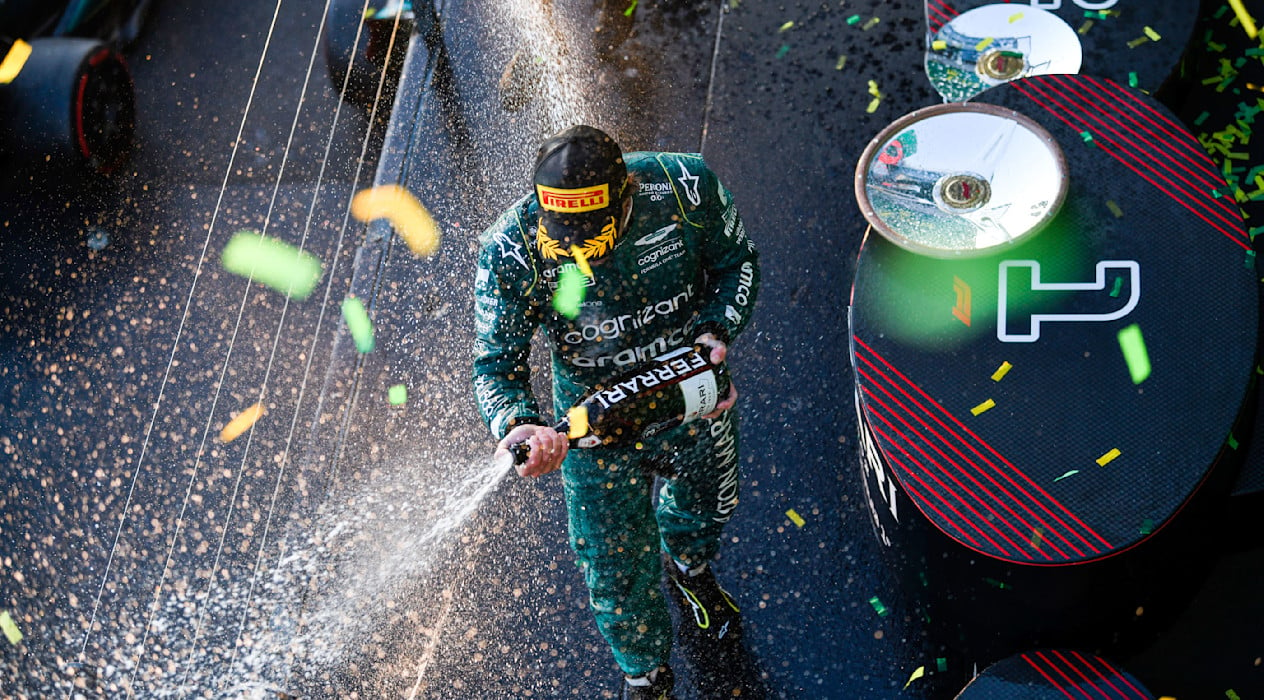
The podium isn't quite as simple as P1, P2 and P3. The F1 rulebook covers every aspect of the sport and that even includes the rostrum. As we head to Monza, renowned for its spectacular podium, we break down the rules around the podium ceremony with our Official Trading Partner AvaTrade.
Last time out, at the Dutch Grand Prix, Fernando took to the rostrum to celebrate the team's seventh podium of the season and the 105th of his career, but there's more to the podium than national anthems, collecting a trophy and spraying champagne.
As we head to the Autodromo Nazionale Monza, home to one of the most iconic podium ceremonies, with its rostrum stretching out towards the start-finish straight where thousands of fans converge to watch the top-three finishers collect their prizes, we've teamed up with our Official Trading Partner AvaTrade to reveal – and help you make sense of – the rules behind the post-race celebrations.
Thirsty work
It's an image that transcends Formula One: jubilant drivers spraying jeroboams of champagne over their team-mates and fans. You'll see actors and actresses spray champagne after winning awards or lottery winners doing so after winning the jackpot.
We have the Le Mans 24 Hours to thank for this tradition.
Champagne was first given to the victor in Formula One at the end of the 1950 French Grand Prix, where a local sponsor gifted a bottle to Juan Manuel Fangio. Only at the end of the 1967 Le Mans 24 Hours was champagne sprayed on the podium – with Dan Gurney embracing the moment and making even more history as he popped the cork.
Nowadays, Italian sparkling wine is sprayed on the podium – while a non-alcoholic alternative such as rosewater or sparkling juice is sprayed in some countries.

Grand designs
What would a podium be without a trophy?
Trophies have been handed to the victors since the start of the World Championship. The Mervyn O'Gorman trophy, named after the influential British safety pioneer and engineer, has been awarded to the British Grand Prix winner since 1948 – though it dates back to the late 1800s, according to the Royal Automobile Club.
Not every trophy takes the form of a classic cup. Last year's Italian Grand Prix trophy took was inspired by a Möbius strip with its infinitely looping shape, while the Monaco Grand Prix trophy depicts an outline of the circuit, and the Australian Grand Prix winner's trophy – the Sir Jack Brabham Trophy – is a massive steering wheel.
There are, however, rules to ensure trophies handed to the drivers aren't too cumbersome.
As set out in the FIA Sporting Regulations, the trophies awarded to the winning driver and constructor must be between 50cm and 65cm tall, while the second- and third-place trophies must be between 35cm and 45cm.
Furthermore, the maximum weight per trophy must not exceed five kilogrammes – and the sport's governing body, the FIA, specifies that 'trophies must be of a design that is capable of being handled and transported without damage'.
As for the trophy winners, only the winning driver, a representative of the winning constructor, the second-place driver and the third-place driver may receive trophies on the podium during the post-race ceremony.
There are also rules dictating how big the rostrum itself can be. The steps for the top three finishers are set in size, with Formula One sending the steps to circuits around the world.
You might not see a red carpet under the drivers; the rules say that the podium 'should' be covered in green or dark blue carpet.
Who's who
In the past, we've seen the likes of ex-US President Bill Clinton and Star Wars creator George Lucas appear on the podium – but who the prizegiver should be is stipulated by the FIA’s Sporting Regulations.
The FIA podium protocol states that the head of state, prime minister or FIA President – or comparable person in the host country – can present the winner's trophy.
Monaco is the only exception to this: tradition dictates that a member of the Monegasque royal family hands out the winners' trophies. This year, Prince Albert II handed the trophy to the winner of the race, Princess Charlene presented the trophy to Fernando who finished second, and royal family member Andrea Casiraghi presented the P3 trophy.
There is much more to the Formula One podium than meets the eye – but what meets the eye is one of the most memorable scenes of a Grand Prix weekend courtesy of its careful choreography, raw emotion from the drivers fortunate enough to grace the rostrum and the passionate fans cheering them on. F1's Sporting Regulations help ensure that one of the sport's most iconic traditions remains a spectacle to savour.
Learn more with AvaTrade
In the same way that a racing driver can constantly learn and improve using data, AvaTrade encourages traders to hone and refine their own skills – courses are created by experts, free to access, tightly focused and comprehensive.
You can discover more about our partnership with AvaTrade and access a suite of free educational resources designed to help you enhance your trading skills.

AVATRADE EXPLAINS THE F1 RULEBOOK
I / AM membership
The ultimate fan experience.
Get closer to the team with unparalleled access, behind-the-scenes insights and once-in-a-lifetime experiences, and enjoy exclusive competitions, rewards, offers and more.









































